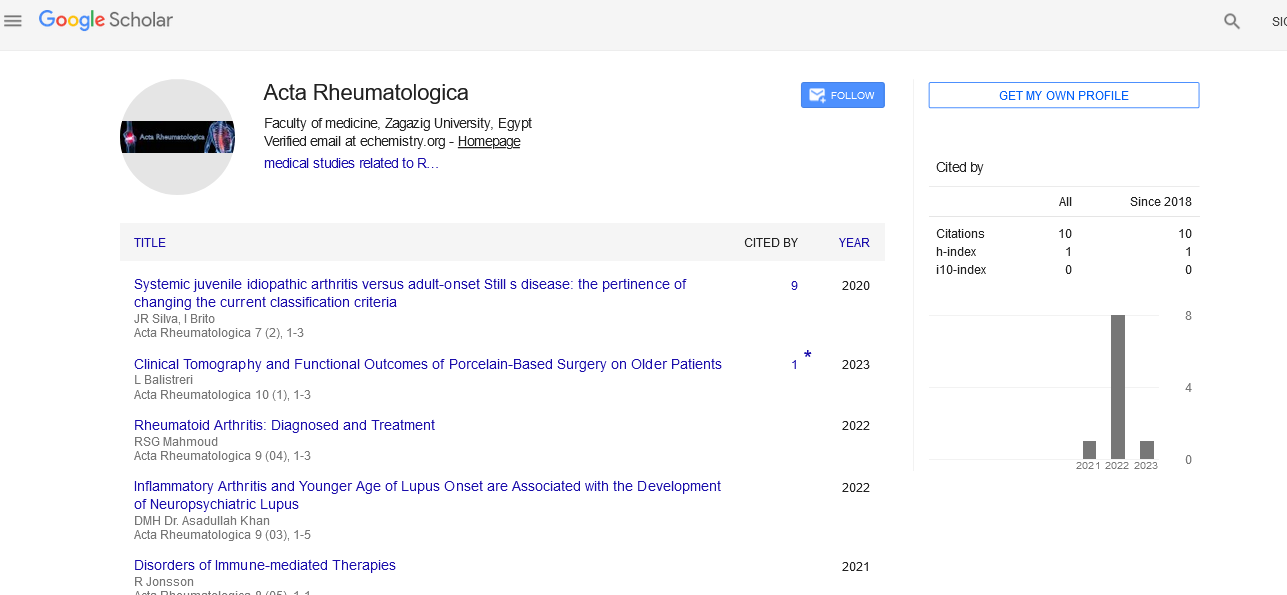Perspective - (2024) Volume 11, Issue 1
The Architectural Marvel of the Human Body: A Comprehensive Exploration of Bone Structure and Function
Ruitao Yu*
Department of Rheumatology, Qingdao University, Shan Dong Sheng, China
*Correspondence:
Ruitao Yu, Department of Rheumatology, Qingdao University, Shan Dong Sheng,
China,
Email:
Received: 10-Jan-2024, Manuscript No. IPAR-24-14410;
Editor assigned: 15-Jan-2024, Pre QC No. IPAR-24-14410 (PQ);
Reviewed: 30-Jan-2024, QC No. IPAR-24-14410;
Revised: 07-Feb-2024, Manuscript No. IPAR-24-14410 (R);
Published:
15-Feb-2024
Introduction
Bones, the sturdy scaffolding of the human body, serve as
more than just a skeletal framework. Beyond their structural
role, bones play a vital part in supporting mobility, protecting
organs, and even contributing to metabolic functions. In this
comprehensive exploration, we delve into the intricacies of bone
structure, formation, and the multifaceted functions that make
these mineralized tissues indispensable for human life.
Description
Bone composition and microarchitecture
Matrix and cells: Bones are a dynamic and living tissue,
composed of a mineralized matrix and various cell types. The
matrix, primarily made up of calcium phosphate and collagen
fibers, provides strength and flexibility. Osteoblasts, osteocytes,
and osteoclasts, the key cellular players, orchestrate bone
formation, maintenance, and remodeling.
Trabecular and cortical bone: Bone tissue is classified into
two main types: Trabecular (spongy) and cortical (compact).
Trabecular bone, found in the interior, forms a lattice-like
structure, providing strength while minimizing weight. Cortical
bone, on the other hand, forms the dense outer layer, offering
protection and structural support.
Bone development and growth
Embryonic formation: The journey of bones begins in the
embryonic stage through a process called ossification. Initially,
the skeleton is formed from cartilage, which is gradually
replaced by bone tissue. This intricate process lays the
foundation for the skeletal structure that will support the
growing body.
Childhood growth: During childhood, bones undergo a
remarkable growth process driven by the activity of growth
plates. These cartilaginous regions allow for longitudinal bone
growth until adolescence, when growth plate closure signifies
the end of vertical bone development.
Bone remodeling: Throughout life, bones undergo constant
remodeling, a delicate balance between bone resorption and
formation. Osteoclasts break down old or damaged bone, while
osteoblasts contribute to the formation of new bone tissue. This
dynamic process ensures the maintenance of bone density and
strength.
Bone as a metabolic hub
Mineral homeostasis: Bones act as a reservoir for essential
minerals, particularly calcium and phosphorus. This reservoir
plays a critical role in maintaining mineral homeostasis in the
body, contributing to various physiological processes such as
nerve transmission, muscle contraction, and blood clotting.
Hematopoiesis in bone marrow: The bone marrow, found
within the cavities of certain bones, serves as a crucial site for
hematopoiesis the formation of blood cells. Red and white
blood cells, along with platelets, are produced in the bone
marrow, highlighting the integral role bones play in the
circulatory and immune systems.
Bone health and disorders
Maintaining bone density: Achieving and maintaining optimal
bone density is essential for overall health. Factors such as
nutrition, physical activity, and hormonal balance influence bone
health. Understanding the importance of these factors is crucial
in preventing conditions like osteoporosis, where bones become
fragile and prone to fractures.
Common bone disorders: Various disorders can affect bone
health, ranging from congenital conditions like osteogenesis
imperfecta to acquired disorders such as osteoarthritis and
rheumatoid arthritis. Exploring the underlying mechanisms and
potential interventions for these disorders is essential for
advancing medical care.
Innovations in bone research and treatment
Biomechanics and engineering: Advances in biomechanics
and bioengineering have paved the way for innovative
treatments, including bone grafts, implants, and tissue
engineering. These approaches aim to restore bone structure and function, particularly in cases of trauma, degenerative
diseases, or congenital abnormalities.
Therapeutic approaches: From pharmaceutical interventions
to regenerative medicine, a spectrum of therapeutic approaches
is being explored to enhance bone health. Targeting specific
pathways involved in bone remodeling and regeneration holds
promise for developing more effective treatments with fewer
side effects.
The future of bone research
Genetics and personalized medicine: As our understanding of
genetics expands, personalized approaches to bone health may
become a reality. Identifying genetic markers associated with
bone disorders can aid in early diagnosis and the development
of targeted therapeutic strategies.
Emerging technologies: Cutting-edge technologies, including
advanced imaging techniques and precision medicine, are
transforming our ability to study bones at the molecular and
cellular levels. These tools offer unprecedented insights into
bone biology, paving the way for more precise diagnostics and
treatments.
Conclusion
Bones, the silent architects of the human body, are a marvel
of nature, embodying strength, resilience, and adaptability.
Beyond their structural significance, bones are dynamic, living
tissues integral to numerous physiological processes. From the
intricacies of bone formation to the forefront of research in
regenerative medicine, our understanding of bones continues to
evolve, holding promise for innovative treatments and
personalized approaches to bone health. As we unlock the
secrets of this remarkable tissue, we pave the way for a future
where bone disorders may be not just managed but prevented
and, in some cases, even reversed.
Citation: Yu R (2024) The Architectural Marvel of the Human Body: A Comprehensive Exploration of Bone Structure and Function. Acta Rheuma Vol:11 No:1





